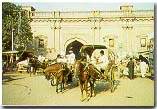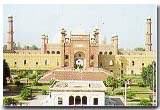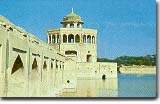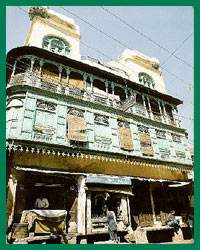BASIC INFORMATION
- Population:
- 5,129,214
- Language:
- Urdu and Punjabi
- Phone Code:
- 041
- Traditional Dishes:
- Siri Paye, Nihari, Halwapooree,Boong
- Activities / Interests:
- Parks, HistoricalPlaces, Mosques,
- Shrines:
- Sheikh Ali-bin-Usman hajweri(Datadarbar)
- Best Time To Visit:
- March
PLACE TO VISIT
Situated on the east bank of the Ravi River, Lahore is very old. Legend traces its origin to Loh, the son of Rama Chandra, the hero of the Ramayana, but history records that it began as a dependency of the 8th century AD Hindu ruler, Lalitiditya. In the early 11th century it came under Muslim rule and evolved as a centre of Islamic culture and learning as well as trade and commerce. In the 13th century it was depopulated and razed to the ground by the Tartar-Mongol hordes of Genghis Khan. Timurlane and his Muslim Turks also arrived and destroyed the city. Lahore was a cultural and intellectual centre during both the Moghul and British eras, and it's an atmosphere which still pervades today, but it is the diversity and contrast of the different sections of the city which make Lahore interesting. Apart from local tourists with their blaring transistors, you could almost be back in the Moghul era. Lahore is 213 metres above sea level and has a population of approximately 3 million. The temperature here drops down to 10C in winter, but in summer can soar to 40C or more. The best time to visit is straight after the monsoon period when the weather is cool and pleasant.
The Old City :
In the Mughal days the Old City was surrounded by a 9-meter high brick wall and had a rampart running around it with a most connected with the River Ravi, which served as a protection for the city.
A circular road around the rampart gave access to the city through thirteen gates. Some of the imposing structures of these gates are still preserved. In the bazaars of the Old City one still comes across tiny shops where craftsmen can be seen busy turning out master-pieces in copper, brass, silver as well as textiles in the traditional fashion.
Royal Fort Lahore:
Although most parts of the Royal fort were constructed around 1566 AD by the Mughal Emperor, Akbar the Great, there is a evidence that a mud fort was in existence here in 1021 AD as well, when mud fort and constructed most of the modern Fort, as we see it today, on the old foundations. Constructions of the fort dates back to the early Hindu period.
The Royal Fort is rectangular. The main gates are located alongside the centre of the western and eastern walls. Every succeeding Mughal Emperor as well as the Sikhs, and the British in their turn, added a pavilion, palace of wall to the Fort. Emperor Jehangir extended the gardens and constructed the palaces that we see today in the Jehangir's Quadrangle, while Shah Jehan added Diwan-e-Khas, Moti Masjid (Pearl Mosque) and his own Sleeping Chambers. Aurangzeb built the impressive main gate, which faces the Hazoori Bagh lying in between the Badshahi Mosque and the fort. The famous Sheesh Mahal or Place of Mirrors is in the northeast corner of the fort. This is the most beautiful palace in the fort and is decorated with small mirrors of different colours set. The part of the wall of the elephant Steps towards the forts inner gate are scarred by bullet marks, bearing testimony to the Sikh Civil War of 1847 AD. A party of Sikhs had mounted their guns on one of the minarets of the mosque across the courtyard from where they fired on their opponents. the Sleeping Chamber of Mai Jindan houses a very interesting museum with relics from Mughal and the Sikh periods.
Badshahi Mosque:
The Imperial or the Badshahi Mosque is across the courtyard from Alamgiri Gate of the Lahore Fort. Emperor Aurangzeb, the last of the great Mughals, built the Mosque, which is made up entirely of red sandstone, in a record time of two and-a-half years. Its construction was completed by 1674 AD. It has a beautiful gateway, which measures 21.33 metres in length and a courtyard that measures 161.5 x 160.6 metres and is said to be the largest mosque courtyard in the world for outdoor prayers. The marble domes cover seven prayer chambers. Four lofty minarets stand at the four corners of the mosque, each with an outer circumference of 20 metres, soaring up to 54 metres. In the chambers above the Gate of the mosque, are housed relics attributed to the Holy Prophet of Islam Peace be upon him, his daughter and his son-in-law and are said to have been brought to the sub-continent by Amir Taimur. Within the Mosque almost all the colours have been used for painting the floral designs but the overall effect remains one of sobriety, piousness and simplicity.
Meenar-e-Pakistan :
Minar-e-Pakisan is a new landmark in Lahore and stands in the Iqbal Park to commemorate the date when a resolution was passed there back in 1940 demanding the creation of separate homeland for the Muslims of this sub-continent. The Minar is a blend of Mughal and modern architecture and has been very boldly designed. The Minar is about 60 metres tall.
The Golden Mosque :
Golden Mosque is also situated in the Kashmiri Bazaar. Nawab Syed Bhikari Khan, who was Deputy governor of Lahore, built it in 1753 AD, It is remarkably beautiful with three golden domes.
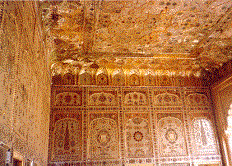
Sikh Monuments:
Samadhi of Maharaja Ranjeet Sing ::
The Ashes of the great Sikh ruler of Punjab, Maharaha Ranjeet Singh, and of his four wives and several slave girls lie in a dome adjacent to the Hazoori Bagh.
Wazir Khan's Mosque:
In the old part of the town and off the Kashmiri Bazaar, reputedly the most beautiful Mosque in the sub-continent is situated. Hakim Ilmuddin who was Minister to shah Jehan and was generally known as Wazir Khan built the Mosque in 1683 AD. It is a marvellous specimen of the work and arabesque paintings.
Shalimar Gardens:
Three miles east of Lahore are the famous Shalimar Gardens laid out by the Mughal emperor Shah Jehan in 1642 AD. The Gardens are spread out in typical Mughal style and are surrounded by high walls with watchtowers at the four corners. Originally, the gardens were spread over seven ascending terraces, but only three remain now, which cover an area of about 42 acres. The brickwork of the
floors of the three terraces has been repaired according to their original designs, which differ on all three terraces. There is a marble pavilion under which water flows and cascades down over a carved, marble slab creating a waterfall effect. Across the waterfall is a marble throne. At the end of the second terrace is a beautiful structure called Sawan Bhadon, a sunken tank niches on its three sides. Water cascades down from it in sheets in front of the niches, producing the sound of falling rain. In the olden times, small oil lamps were placed in the niches, which reflected myriad colours, through the water. Shalimar gardens have the proud privilege of being the stage of all-important state receptions. Outside its walls the annual festival of Mela Chiraghan is held every March,special lights on the first and second terraces of the Gardens have been installed and the area is illuminated half-an-hour after sun set.
Shrines/Mausoleums :
Close to the junction of the Lower Mall and the Circular Road is theShrine of Data Sahib : shrine of Data Sahib. Data Sahib was a great sufi saint whose well known work, "Kashf-ul-Mahjub" has been translated from the original Persian into several European languages and is considered a classic. Attached to the Shrine is a beautiful mosque.
Allama Iqbal's Tomb :
Outside the Badshahi Mosque, near its steps, lies the tomb of Allama Iqbal, the poet philosopher of the East. The mausoleum is a mixture of Afghan and Moorish styles of architecture and is constructed entirely of red sandstone, which was quarried and brought from Rajasthan.
Mausoleum of Emperor Jehangir :
The tomb of the fourth great Mughal emperor, Jehangir, lies three miles north-west of Lahore across the River Ravi. It has a majestic structure made of red sandstone and marble. The outer entrance to the tomb opens out into a court-yard which was used as a caravan Serai during Mughal times. An entrance to the right leads into a Mughal garden with exact geometrical pattern balancing each side. The marble tomb is approached from four corridors leading from the garden. Intricate marble screens close three of these corridors. The marble grave is elaborately inlaid with floral designs and the 99 Attributes of God are inscribed on its two sides. On the top is a verse from the Holy Quran. Queen Noor Jehan and the Emperor?s son Shah Jehan built the tomb, around 1637 AD.
Noor Jehan's Tomb :
The Empress Nur Jehan, "Light of the World" was the only empress whose name appeared on the coins of the Mughal Empire. She was buried in 1845 AD at Shahdara (Lahore) outside Jehangir's mausoleum across the railway line. Her tomb once had a marble cenotaph, which she had built herself during her lifetime. After the decline of Mughal rule, the tomb suffered extensive damages along with her husband's tomb at the hands of Sikh marauders when they gained power during the early part of nineteenth century. Both were stripped of most of its original beauty and splendour. All treasures and tiles, it is said were carted off to decorate the Golden Temple of Amritsar India.
Qutbuddin Aibak's Tomb :
Muhammad Ghauri appointed him Governor of India in 1191 AD. He established the Slave Dynasty on the death of Muhammad Ghauri in 1206 when he assumed independence of his reign and was followed by nine other slave kings. He was a patron of the building art and is known to have erected some monumental stone buildings in Delhi and elsewhere. A very avid player of polo, he died in Lahore in 1210 AD while playing the game. His tomb can be visited in Anarkali Bazaar
Asif Khan's Mausoleum :
In the courtyard near Jehangir tomb lies buried his brother-in-law, Asif Khan, father of Shah Jehan's beloved Queen Arjumand Bano. He lies in a tomb today shows little of its former splendour.
Museums :
Lahore Museum :
Opposite the old University Hall, a Mughal style building on the Shahrah-e-Quaid-e-Azam, houses the Lahore Museum. the Museum contains some fine specimens of Mughal and Sikh door-ways and wood-work and has a big collection of paintings dating back to Indo-Pakistan, Mughal, Sikh and British times. It has also a collection of musical instruments, ancient jewellery, textile, pottery and armoury. There are also relics from the Graeco-Pactrian times as well as some Tibetan and Nepalese exhibits.
Faqirkhana Museum :
A very large and interesting private Museum known as Faqirkhana lies inside the Bhati Gate and is worth visiting. The museum houses a variety of old paintings, including some by great masters, original manuscripts in different languages and artefacts from South East Asia and the Indo-Pak sub-continent.
Fairs and Festivals :
Mela Chiraghan :
The Festival of Lamps of Mela Chiraghan is a very important and popular event. This is celebrated every spring on the last Friday of March outside the Shalimar Gardens. During the Festival, people from all walks of the life gather from all over the province to actively participate in the Festival.
National Horse and Cattle show :
One of the most famous annual festivals. The National Horse and Cattle Show is also held in Spring in the Fortress Stadium. During the week long activities there is a display of the finest livestock, horse and camel dances, tent pegging colourful folk dances from all regions of Pakistan, mass band displays and tattoo shows in the evening.
Basant - Kite flying Festival :
With the advent of spring, skies of Lahore are resplendent with all types of sizes of kites. The entire population participates in kite flying matches to herald the coming of Spring.
Bazaars/Shopping Centres :
Anarkali Bazaar :
Anarkali bazaar is the most fascinating of the city's many bazaars. The alleys and lanes of this bazaar are full of exciting wears, especially traditional crafts like leather wear, embroidered garments glass bangles, beaten gold and silver jewellery, creations in silk. Anything that you wish for a bargain, it is named after the famous courtesan of Akbar's court called Anarkali (Pomegranate Blossom). Anarkali too has its share of historical monuments. There is the grave of Emperor Qutbuddin Aibak, who died falling off his horse playing polo. And Mahmud Ghaznavi's General Malik Ayyaz buried in the commercial area of Rang Mahal.
Excursions from Lahore :
Hiran Minar :
Hiran Minar is set in peaceful environs near Lahore. It was constructed by Emperor Jehangir as a monument to Hansraj, one of his pet antelopes. It is a popular picnic resort with a lake and boating facilities.
Chhanga Manga :
Chhanga Manga is a man-made forest 68 kms from Lahore. There is a lake, and a miniature railway which winds its way through its forest. Chhanga Manga has 12,510 acres of plantations. It is a popular picnic spot spread over 50 acres with a lake and row boats, motor boats, children's park, swimming pool, cafeteria, canteen and rest houses.
Jallo Park :
The Park is 28 kms from Lahore. It can be visited by road and by rail. A rail car leaves for Jallo Railway Station every half hour. Spread over an area of 450 acres, it has expanses of lawns, a forest research centre, a children's park, zoo, a small museum and a gift shop.
Pakistan-India Border :
This checkpoint is about 30 k ms from Lahore and is the crossover point for travellers into India by the land route. It is open daily to foreigners only (except Indian and Pakistani nationals) from 9.00 a.m. to 3.00 p.m. PST.
Gates
The idea of gates, walls and fortification is as old as history can lead. Throughout the human history, mentioned has been made of walls and gates to protect the residence, and of those to breach the same. Who not knows walls and gates of Troy, Babylon, Ninevaeh, Khyber, Dehli or Lahore. According to history, Akbar during his residence at Lahore(1584 -1598) enclosed the city with brick-walls and gates of considerable height and strength. These city walls were fast falling into decay, when Ranjit Singh rebuilt them in 1812 to a great extent. The city walls, which were formerly more than 30 feet in height, were reduced to 15 feet for sanitary purposes in British Period and along with the renovation of the gate - meeting the modern requirements. A time came when these walls altogether vanished leaving their gates standing alone without purpose - only the reminiscent and glory of the past. Comparison between the on-ground existing gates of Lahore and the old pictures and drawings of old Lahore, showing these gates, on display in Lahore Museum and books, do not coincide. Something is missing? Yes, present existing gates such as Dehli Gate and their drawings are quite different. These are renovated gates of the British Period. If that is so, what was their original shape and structure! A closer look on museum and contemporary drawings such as that of Taxali Gate reveals that as a defensive measure against any intruder or enemy, there used to be no direct or straight approach to these gates but one had to face obstruction like semi-circular or rectangular type structure od sufficient height, strengthened with brick-walls stones and marter - the case maybe was built in front of the actual gate leaving the access to the gate from the side only. In olden times, same was the case with gates of Lahore. These were 12 circling the city.
hope you will find all of this interesting......
see you again
The most prominent gate was 'ROSHANI GATE' situated at the northern extreme of the city, adjacent to the Lahore Fort. It derived its name from ROSHNI - the light, as it was lit immensely at night . Being Being the principal entrance form fort to city, it was most frequented by the Omerahs, Courtiers, Royal servants and the retinues. The quarters about here are profusely lighted up it was so-called gate of Light. It is also supposed that the gate owes its name to the people of Roushnai sect which sprung up in Akbar's time under Afghan, but the authority of the Roushnai was confined to the hills of Suliman and Khyber ranges and they had no influence beyond these hills. Among many a legends and tales of this magnificent gate, Ranjit Singh was succeeded by his elder son Kharak Singh, who died in Lahore in 1840 and was succeeded by his son Naunihal Singh. This later met his death by the fall of a portion of the archway of the gate. "Leading to Hazoori Bagh as he was returning after performing after performing the funeral rides of his father, hand-in-hand with Mian Uddam Singh, the eldest son of his chief minster Dhiyan Singh, as both entered the archway, a loud crash was heard and it was found that a frement of the upper wall had fallen and crushed the two young men walking under it." At present this gate is in dilapidated condition aNand is permanently closed as being the part of the of Mahaeaja Ranjit Singh and others.
The palaces and pleasure houses have become one with dust, but many of the tombs, mausoleums and mosques remain, some of them in a fairly good state of preservation. Prominent among the town?s present day brick and adore structures are the wind-catchers that top them a cooling device that serves well during the long blistering summers. Amidst Thatta`s narrow alleys and lanes are quaint bazaars that offer unexpected bargains in hand-blocked and hand-dyed fabrics, embroidery work and bead necklaces.
Taxali Gate
F.S Ijazuddin in his book "Lahore states: "Of the 12 gates perforating the outer wall of the old city only one - the Taxali gate ,taking its name from Taxal or royal Mint located nearby, provided access through the otherwise uninterested wall that extended the western length of the city. It was heavily fortified and was designed to protect the city from any attack from the west-ward." As per Latif's LAHORE, archeologist has conjectured not without some grounds that the name bears an illusion to the ancient city of Taxila. However this maybe, it is clear that the name must have been derived from the Takkas who were once the undisputed masters of the Punjab. With the passage of time this gate is completetly vanished.
Bhati Gate
This gate is named after Bhattis - a Rajput tribe who inhabited this place in oldtimes. This gate is situated at the south-western bend of the city in its renovated form.
Lahore Gate
This gate is named after the city of Lahore. It is said that when Malik Ayaz rebuilt the town in the timeof Mahmood Ghaznavi, the quarters of the city was first populated about this gate. As Dehli Gate facesDehli and Kashmiri Gate faces Kashmir, so it is said that they derived their names from these environs. Present Ichra was the actual Lahore in Hindu Raj, so this gate faces in that direction, derives its name from the so-called Lahore. Maharaja Ranjit Singh who besieged Lahore with a large force, it was Muhkim Din Chaudary in connivence with the Raja, was the incharge of the Lahorei Gate, opened it secretly to the invader who took possession of the city. This gate has - during the ascendency wars between the sikh nobles, sardar Hira Singh, son of Raja Dhiyan Singh, chief minister of Ranjit Singh was put to death and his head hung up for public view at this gate. This gateway still exists in its renovated form and is famous for being one of the main entrances of the city.
Mochi Gate
At the south-eastern extremity of the city, thisgate was situated between Shah Aalmi and Akbari Gate. Actually its name was Moti Gate. It was correpted to Mochi Gate. It is said that the name of the gate was after Moti Ram, an officer of Akbar, who resided here at that time .At the former site of the gate, a prominent grave of a learned saint can still be seen. In olden times, this grave was in one of the cubicals of the gate.
Akbari Gate
This gate was named after Mohamad Jalal-ud-Din Akbar who rebuilt the town and thecitadel. No traces of it exist today.
Dehli Gate
It is so-called from its opening on to the high road from Lahore to Dehli. This gate being a prominent one has witnessed a lot of incidents. It is present in its renovated form and is still a flourishing place. Many a historical places such as Shahi Hamam, Chitta Darvaza, Masjid Wazir Khan and a number of old havalies are situated inside this gate.
Yakki Gate
The original name was 'ZAKI' - after the name of a saint who according to tradition fell fighting against the mughals, while gallantly defending the city. His head was cut off at the gate but the trunk continued fighting for sometime, so called, and fell close by. Head and the trunk of the saint was buried at their fallen places seperately and both are revered to this day. No traces of this gate are found now.
Sheran Wala Gate
This gate is situated at the north-eastern extremely of the city. In olden times, theriver flowed by the city walls. The gate was terefore, named as 'KHIZR GATE' after the name of KHIZAR ILYAS - the patron saint of running water and streams and the discoverer of the water of immortality. During the reign od Ranjit Singh while the River Ravi changed its course away from the city walls, Ranjit Singh kept here two domesticated lions and the gate came tobe called 'LIONS' or 'SHERAN WALA GATE'.
Kashmiri Gate
So named because it faces the direction of Kashmir. It still exixts in its renovated form.
Masti Gate
The name is a corruption of 'MASJADI GATE' reffering to the mosque of Mariam Makani, mother of Akbar, situated in itsimmediate vicinity. A little trace of this gate in its renovated form can still be seen.
Mori Gate
The so-called 13th gate, named as MoriGate, was infact no gate as in old time this placewas used as outlet for the refused and the sweepings of the city. These gates have lost their grandeur and are in a dilapidated condition, To a common eye they are no more than a ruined structure, but for the history lovers there is still much more to discover.


